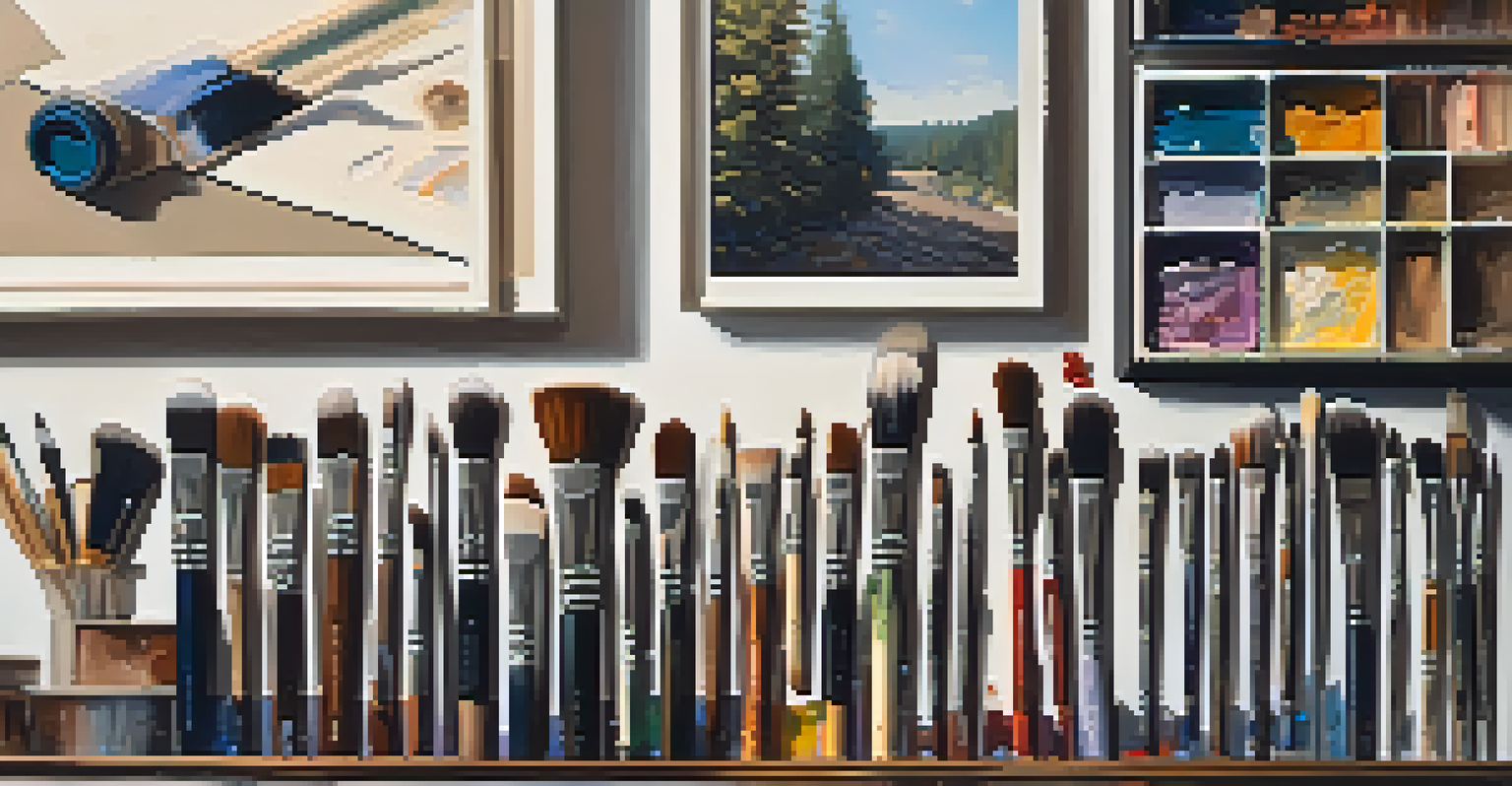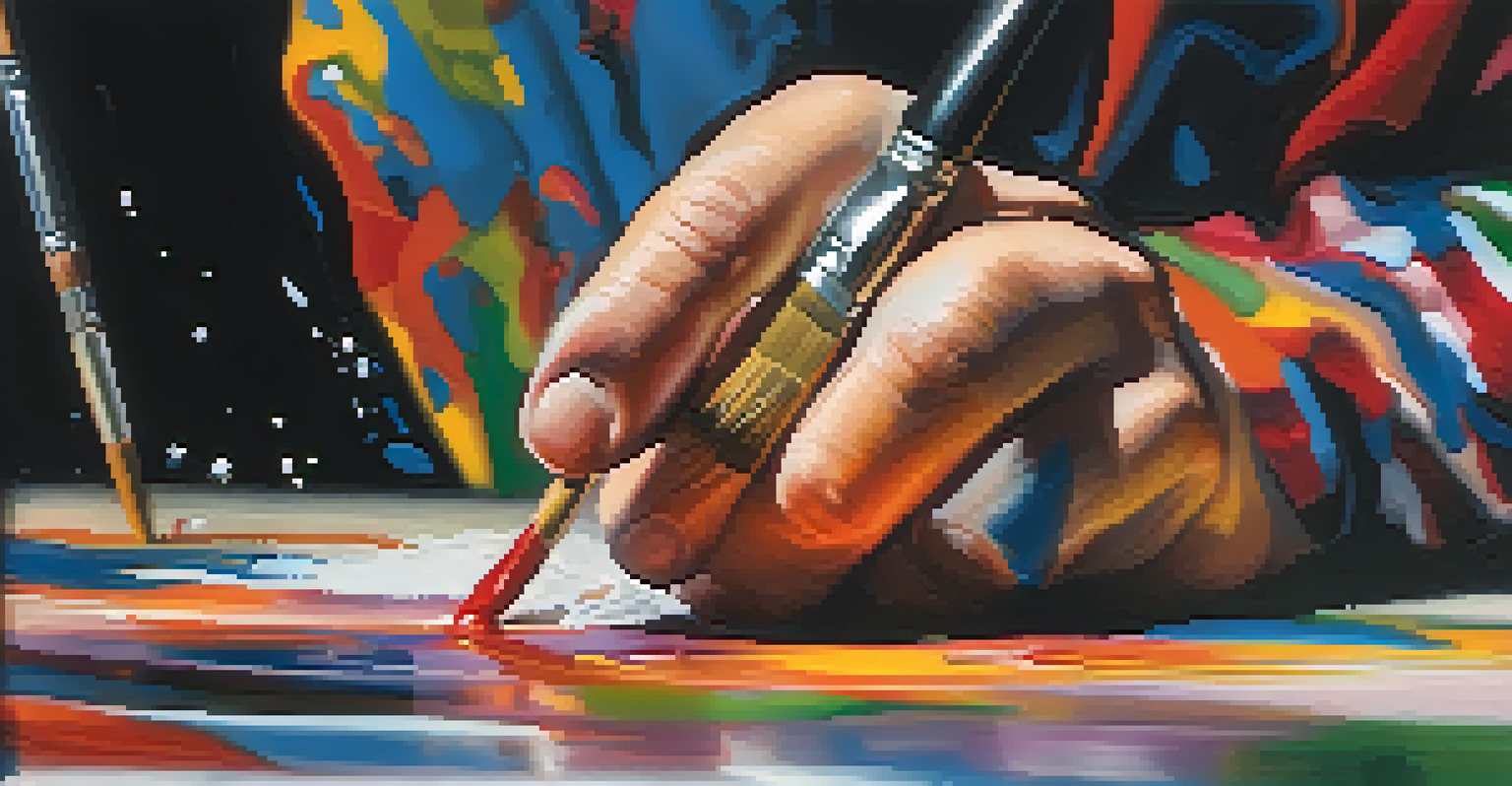Capturing Emotion: Brush Techniques for Artistic Storytelling

Understanding the Power of Emotion in Art
Art has a unique ability to convey emotions that words often cannot. Through colors, shapes, and textures, artists can evoke feelings ranging from joy to sorrow, allowing viewers to connect on a deeper level. Understanding this power is the first step in mastering artistic storytelling.
Art is the most beautiful of all lies.
When you tap into emotions, you create a narrative that resonates with your audience. Think of how a vibrant sunset can evoke feelings of peace, while dark, stormy clouds might conjure up tension or sadness. These emotional responses are what make art memorable and impactful.
Thus, as you explore brush techniques, consider how each stroke can influence the mood of your piece. By intentionally choosing your colors and styles, you can guide the emotional journey of your viewer, making your artwork not just a visual experience but a poignant story.
Choosing the Right Brush for Emotional Impact
Different brushes can create vastly different effects, influencing the emotional tone of your artwork. A soft, round brush can produce gentle, flowing lines, evoking calmness and serenity. In contrast, a stiff, bristled brush may create sharp, aggressive strokes, stirring feelings of tension or chaos.

Consider how brush shape and size can alter the viewer's perception. For instance, large brushes can cover more canvas quickly, generating a sense of spontaneity, while smaller brushes allow for fine detail and precision, which can convey intimacy and focus.
Emotion Drives Artistic Storytelling
Art's ability to evoke emotions allows for a deeper connection between the artwork and its audience.
Experimenting with various brushes will help you discover which tools best express the emotions you wish to convey. Each brush is like a character in your storytelling, with its own personality and voice, contributing to the overall narrative.
Color Choices: The Language of Emotion
Color is a powerful tool in art, capable of evoking strong emotional reactions. Warm colors like red and orange can trigger feelings of warmth and passion, while cool colors like blue and green often evoke calmness and tranquility. Understanding color theory can enhance your storytelling significantly.
A painting is worth a thousand words.
Using colors strategically can help guide the viewer's emotions throughout your piece. For example, starting with darker hues and gradually transitioning to lighter shades can symbolize a journey from despair to hope, capturing the essence of transformation in your narrative.
Always remember that color is subjective and can mean different things to different people. Trust your instincts, and feel free to experiment with unexpected color combinations to create unique emotional responses in your artwork.
Layering Techniques for Depth and Complexity
Layering isn’t just a way to add depth; it’s a technique that can also enhance emotional storytelling. By applying multiple layers of paint, you can create a rich texture that invites viewers to explore your piece more deeply. This complexity can mirror the intricacies of human emotion.
For instance, using transparent layers can create a sense of mystery, while thick, opaque layers can convey strength and boldness. Each layer adds another dimension to your story, allowing viewers to peel back the surface and discover the underlying narrative.
Color Choices Shape Viewer Emotions
Strategically using color can guide the emotional journey of viewers, enhancing the narrative of the piece.
As you practice layering, think about how each brushstroke interacts with the ones beneath it. This interplay can reflect the complexities of feelings, making your artwork a more profound exploration of emotion.
Expressive Brushstrokes: Conveying Emotion
The way you apply your brush to the canvas can significantly affect the emotion you convey. Quick, erratic strokes might express anger or chaos, while slow, deliberate strokes can evoke calm and contemplation. This expressiveness is essential in storytelling through art.
Consider how the pressure you apply affects the outcome. Lighter pressure can create soft, gentle lines, while heavy pressure results in bold, striking marks. Each choice you make with your brush contributes to the emotional narrative of your piece.
As you refine your technique, pay attention to how different strokes resonate with your intended message. This awareness will empower you to use brushstrokes as a language of their own, speaking volumes without saying a word.
Narrative Composition: Arranging Elements Thoughtfully
Composition plays a crucial role in storytelling through art. The arrangement of elements on your canvas can guide the viewer's eye and influence their emotional journey. A well-thought-out composition will draw viewers in and keep them engaged.
For example, a central focal point can create a sense of importance or urgency, while negative space can evoke feelings of isolation or contemplation. By manipulating these elements, you craft a narrative that unfolds before the viewer's eyes.
Composition Influences Emotional Impact
The arrangement of elements on the canvas plays a crucial role in directing the viewer's emotional experience.
Always consider how the placement of each element contributes to the overall story you want to tell. Thoughtful composition can elevate your artwork, transforming it into a captivating emotional experience.
Final Touches: Enhancing Emotional Resonance
As you near completion, those final touches can make all the difference in evoking the desired emotion. Small details like highlights, shadows, or additional texture can enhance the narrative, drawing attention to specific elements and deepening the emotional impact.
This is the stage where your intuition as an artist truly comes into play. Trust your instincts, and don’t be afraid to add or remove elements that don’t serve the emotional core of your piece. Sometimes, less is more, and a subtle change can create a significant shift in feeling.

Ultimately, these final adjustments are what transform your artwork from a simple image into a powerful story that resonates with viewers. Taking the time to refine these details will ensure your artistic storytelling truly captures the emotions you aim to convey.